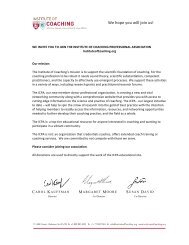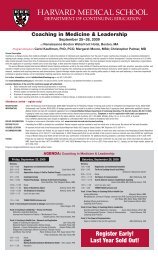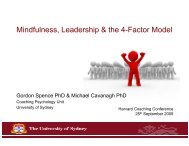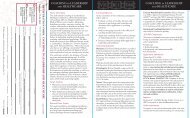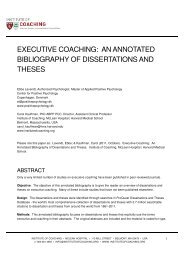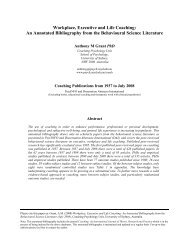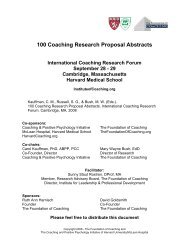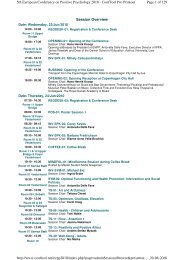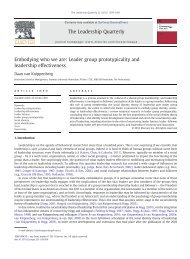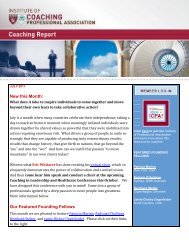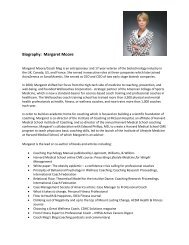The Journal of Positive Psychology, 2013, Vol. 8, No. 5, 365-375
The Journal of Positive Psychology, 2013, Vol. 8, No. 5, 365-375
The Journal of Positive Psychology, 2013, Vol. 8, No. 5, 365-375
- No tags were found...
You also want an ePaper? Increase the reach of your titles
YUMPU automatically turns print PDFs into web optimized ePapers that Google loves.
This article was downloaded by: [Institute <strong>of</strong> Coaching Pr<strong>of</strong>essional Assoc], [Institute <strong>of</strong> Coaching]On: 12 August <strong>2013</strong>, At: 13:52Publisher: RoutledgeInforma Ltd Registered in England and Wales Registered Number: 1072954 Registered <strong>of</strong>fice: Mortimer House,37-41 Mortimer Street, London W1T 3JH, UK<strong>The</strong> <strong>Journal</strong> <strong>of</strong> <strong>Positive</strong> <strong>Psychology</strong>: Dedicated t<strong>of</strong>urthering research and promoting good practicePublication details, including instructions for authors and subscription information:http://www.tandfonline.com/loi/rpos20Are meaning and purpose distinct? An examination <strong>of</strong>correlates and predictorsLogin S. George a & Crystal L. Park aa Department <strong>of</strong> <strong>Psychology</strong> , University <strong>of</strong> Connecticut , 406 Babbidge Road, Unit 1020,Storrs , CT , 06269-1020 , USAPublished online: 17 Jun <strong>2013</strong>.To cite this article: Login S. George & Crystal L. Park (<strong>2013</strong>) Are meaning and purpose distinct? An examination <strong>of</strong> correlatesand predictors, <strong>The</strong> <strong>Journal</strong> <strong>of</strong> <strong>Positive</strong> <strong>Psychology</strong>: Dedicated to furthering research and promoting good practice, 8:5,<strong>365</strong>-<strong>375</strong>, DOI: 10.1080/17439760.<strong>2013</strong>.805801To link to this article: http://dx.doi.org/10.1080/17439760.<strong>2013</strong>.805801PLEASE SCROLL DOWN FOR ARTICLETaylor & Francis makes every effort to ensure the accuracy <strong>of</strong> all the information (the “Content”) containedin the publications on our platform. However, Taylor & Francis, our agents, and our licensors make norepresentations or warranties whatsoever as to the accuracy, completeness, or suitability for any purpose <strong>of</strong> theContent. Any opinions and views expressed in this publication are the opinions and views <strong>of</strong> the authors, andare not the views <strong>of</strong> or endorsed by Taylor & Francis. <strong>The</strong> accuracy <strong>of</strong> the Content should not be relied upon andshould be independently verified with primary sources <strong>of</strong> information. Taylor and Francis shall not be liable forany losses, actions, claims, proceedings, demands, costs, expenses, damages, and other liabilities whatsoeveror howsoever caused arising directly or indirectly in connection with, in relation to or arising out <strong>of</strong> the use <strong>of</strong>the Content.This article may be used for research, teaching, and private study purposes. Any substantial or systematicreproduction, redistribution, reselling, loan, sub-licensing, systematic supply, or distribution in anyform to anyone is expressly forbidden. Terms & Conditions <strong>of</strong> access and use can be found at http://www.tandfonline.com/page/terms-and-conditions
<strong>The</strong> <strong>Journal</strong> <strong>of</strong> <strong>Positive</strong> <strong>Psychology</strong> 367Downloaded by [Institute <strong>of</strong> Coaching Pr<strong>of</strong>essional Assoc], [Institute <strong>of</strong> Coaching] at 13:52 12 August <strong>2013</strong>Table 1. Versions <strong>of</strong> the Ryff Purpose subscale and PerceivedPersonal Meaning Scale used in current study.Ryff Purpose subscaleI live life one day at a time anddo not really think about thefuture (reverse scored)I tend to focus on the present,because the future nearlyalways brings me problems(reverse scored)My daily activities <strong>of</strong>ten seemtrivial and unimportant to me(reverse scored)I do not have a good sense <strong>of</strong>what it is I am trying toaccomplish in life (reversescored)I used to set goals for myself, butthat now seems like a waste <strong>of</strong>time (reverse scored)I enjoy making plans for thefuture and working to makethem a realityI am an active person in carryingout the plans I set for myselfSome people wander aimlesslythrough life, but I am not one<strong>of</strong> themI sometimes feel as if I have doneall there is to do in life(reverse scored)Perceived PersonalMeaning ScaleFeel your life as a wholehas meaningDerive a great deal <strong>of</strong>meaning from your pastlifeFind your life verymeaningfulLook forward to ameaningful life in thefuturefocuses on purpose – the items directly refer to goals,aims, a sense <strong>of</strong> direction, and behavioral engagementwith current activities. In contrast, items on the PPMSrefer specifically to meaning, using the term ‘meaning’ –the four items ask subjects about the degree to whichthey feel that their present, past, future, and overall lifehas ‘meaning’ or feels ‘meaningful.’ But how can we besure that the PPMS’ use <strong>of</strong> the term meaning fosters participants’focus on the underlying construct <strong>of</strong> meaningand not purpose? If experts use these terms interchangeably,would the PPMS’ use <strong>of</strong> the term meaning instead<strong>of</strong> purpose make any substantive difference toparticipants? How can we be sure that participants arenot rating their sense <strong>of</strong> goals, aims, and direction in life(i.e. their purpose)? <strong>The</strong>re is evidence to suggest that theterm meaning represents more than merely a sense <strong>of</strong>goals, aims, and direction for individuals. For example,Wong (1998) asked lay people to describe their conceptions<strong>of</strong> an ‘ideally meaningful life.’ Participants’descriptions consisted <strong>of</strong> a whole host <strong>of</strong> topics that aredistinct from what we refer to here as purpose – participantswrote about having religious beliefs, intimate relationships,a sense <strong>of</strong> transcendence, being treated fairly,and living life in fulfilling ways. <strong>The</strong>refore, when theterm meaning is being used, people seem to thinkbeyond mere goals and a sense <strong>of</strong> direction. Thus, thePPMS appears to tap meaning, whereas the Ryff Purposesubscale appears to tap purpose.Expected differences and similarities between meaningand purposeConsidering the conceptual differences between meaningand purpose, we hypothesized that they will have differentpredictors. In particular, we hypothesized that religionand spirituality will be more predictive <strong>of</strong> meaningthan <strong>of</strong> purpose. Religion and spirituality <strong>of</strong>fer a comprehensiveframework to understand life and one’s existenceand thus provide a sense <strong>of</strong> meaning (Park, 2005). Religionand spirituality address existential questions (Batson& Stocks, 2004) and allow for a sense <strong>of</strong> transcendence,thus conferring a sense <strong>of</strong> significance regarding one’slife (Steger, 2012). Although religion and spiritualitymay also provide features <strong>of</strong> purpose such as a sense <strong>of</strong>direction and enthusiasm regarding the future (Emmons,2005), this seems to be a less salient function <strong>of</strong> religionand spirituality than the provision <strong>of</strong> a sense <strong>of</strong> comprehensionand understanding regarding life (Park, <strong>2013</strong>;Park, Edmondson, & Hale-Smith, <strong>2013</strong>).Another two predictors that we expected to differentiallypredict meaning and purpose were optimism andpessimism. Optimism and pessimism can be defined asgeneralized expectancies regarding outcomes (Scheier &Carver, 1985). Optimists have generally positive expectationsregarding the future, whereas pessimists have negativeones. Characteristics <strong>of</strong> purpose such as goals, aims,and a sense <strong>of</strong> direction in life are highly influenced bywhat one expects <strong>of</strong> the future and how s/he expectsthings to turn out. In fact, studies have shown that thepositive and negative expectations that are characteristic<strong>of</strong> optimists and pessimists affect how they construe theirgoals and pursue them (e.g. Jackson, Weiss, Lundquist,& Soderlind, 2002). Optimists see their goals as moreattainable whereas pessimists perceive more difficulties(Carver & Scheier, 2002). Thus, optimism and pessimismmight be linked to individuals’ sense <strong>of</strong> purpose inlife via their effects on expectations. <strong>The</strong>refore, wehypothesized that optimism and pessimism would bemore predictive <strong>of</strong> purpose than <strong>of</strong> meaning.Crises such as cancer can violate individuals’ corebeliefs and goals (Holland & Reznik, 2005; Park,2012a). For example, the goal <strong>of</strong> living a physicallyactive life and/or the belief in a safe world maybe violatedby a cancer diagnosis. We expected participants’perception <strong>of</strong> their cancer diagnosis as violating theircore beliefs and goals to differentially predict meaningand purpose. We expected the perception <strong>of</strong> belief violationsto be inversely predictive <strong>of</strong> meaning as corebeliefs help individuals’ comprehend and understandtheir lives (Jan<strong>of</strong>f-Bulman, 1992; Koltko-Rivera, 2004;Park, 2010) and thus provide a sense <strong>of</strong> meaning. Incontrast, we expected the perception <strong>of</strong> goal violationsto be inversely predictive <strong>of</strong> purpose as core goals are
374 L.S. George and C.L. ParkDownloaded by [Institute <strong>of</strong> Coaching Pr<strong>of</strong>essional Assoc], [Institute <strong>of</strong> Coaching] at 13:52 12 August <strong>2013</strong>Carver, C. S., & Scheier, M. F. (2002). Optimism. In C. R. Snyder& S. J. Lopez (Eds.), <strong>The</strong> handbook <strong>of</strong> positive psychology(pp. 231–243). New York, NY: Oxford University.Cohen, S., Mermelstein, R., Kamarck, T., & Hoberman, H. M.(1985). Measuring the functional components <strong>of</strong> social support.In I. G. Sarason & B. R. Sarason (Eds.), Social support:<strong>The</strong>ory, research and applications (pp. 73–94).Dordrecht: Martinus Nijh<strong>of</strong>f.Crumbaugh, J. C., & Maholick, L. T. (1964). An experimentalstudy in existentialism: <strong>The</strong> psychometric approach toFrankl’s concept <strong>of</strong> noogenic neurosis. <strong>Journal</strong> <strong>of</strong> Clinical<strong>Psychology</strong>, 20, 200–207.Currier, J. M., Holland, J. M., & Neimeyer, R. A. (2006).Sense-making, grief, and the experience <strong>of</strong> violent loss:Toward a mediational model. Death Studies, 30, 403–428.doi:10.1080/07481180600614351Damon, W., Menon, J., & Bronk, K. C. (2003). <strong>The</strong> development<strong>of</strong> purpose during adolescence. Applied DevelopmentalScience, 7, 119–128. doi:10.1207/S1532480XADS0703_2Davis, C. G., <strong>No</strong>len-Hoeksema, S., & Larson, J. (1998). Makingsense <strong>of</strong> loss and benefiting from the experience: Twoconstruals <strong>of</strong> meaning. <strong>Journal</strong> <strong>of</strong> Personality and Social<strong>Psychology</strong>, 75, 561–574. doi:10.1037/0022-3514.75.2.561Debats, D. (1999). Sources <strong>of</strong> meaning: An investigation <strong>of</strong>significant commitments in life. <strong>Journal</strong> <strong>of</strong> Humanistic<strong>Psychology</strong>, 39, 30–57. doi:10.1177/0022167899394003Diener, E., Emmons, R. A., Larsen, R. J., & Griffin, S. (1985).<strong>The</strong> satisfaction with life scale. <strong>Journal</strong> <strong>of</strong> PersonalityAssessment, 49, 71–75. doi:10.1207/s15327752Edmondson, D., Park, C. L., Blank, T., Fenster, J. R., & Mills,M. A. (2008). Deconstructing spiritual well-being:Existential well-being and HRQOL in cancer survivors.Psycho-Oncology, 17, 161–169. doi:10.1002/pon.1197Fetzer Institute/National Institute on Aging Working Group.(1999). Multidimensional measurement <strong>of</strong> religiousness/spiritualityfor use in health research. Kalamazoo, MI: John E.Fetzer Institute.Emmons, R. A. (2003). Personal goals, life meaning, and virtue:Wellsprings <strong>of</strong> a positive life. In C. Keyes & J. Haidt(Eds.), Flourishing: <strong>Positive</strong> psychology and the life welllived(pp. 105–128). Washington, DC: American PsychologicalAssociation.Emmons, R. A. (2005). Striving for the sacred: Personal goals,life meaning, and religion. <strong>Journal</strong> <strong>of</strong> Social Issues, 61,731–745. doi:10.1111/j.1540-4560.2005.00429.xFrankl, V. (1963). Man’s search for meaning: An introductionto logotherapy (Original work published 1959). New York,NY: Pocket Books.Frazier, P., Conlon, A., & Glaser, T. (2001). <strong>Positive</strong> andnegative life changes following sexual assault. <strong>Journal</strong> <strong>of</strong>Consulting and Clinical <strong>Psychology</strong>, 69, 1048–1055.doi:10.1037/0022-006X.69.6.1048Heine, S. J., Proulx, T., & Vohs, K. D. (2006). <strong>The</strong> meaningmaintenance model: On the coherence <strong>of</strong> social motivations.Personality and Social <strong>Psychology</strong> Review, 10, 88–110.doi:10.1207/s15327957pspr1002_1Herzberg, P., Glaesmer, H., & Hoyer, J. (2006). Separatingoptimism and pessimism: A robust psychometric analysis <strong>of</strong>the Revised Life Orientation Test (LOT-R). PsychologicalAssessment, 18, 433–438. doi:10.1037/1040-3590.18.4.433Hicks, J. A., & King, L. A. (2009). Meaning in life as asubjective judgment and a lived experience. Social andPersonality <strong>Psychology</strong> Compass, 3, 638–653. doi:10.1111/j.1751-9004.2009.00193.xHolland, J. M., Currier, J. M., & Neimeyer, R. A. (2006).Meaning reconstruction in the first two years <strong>of</strong> bereavement:<strong>The</strong> role <strong>of</strong> sense-making and benefit-finding. Omega:<strong>Journal</strong> <strong>of</strong> Death and Dying, 53, 175–191. doi:10.2190/FKM2-YJTY-F9VV-9XWYHolland, J. C., & Reznik, I. (2005). Pathways for psychosocialcare <strong>of</strong> cancer survivors. Cancer, 704, 2624–2637.doi:10.1002/cncr.21252Jackson, T., Weiss, K. E., Lundquist, J. J., & Soderlind, A.(2002). Perceptions <strong>of</strong> goal-directed activities <strong>of</strong> optimistsand pessimists: A personal projects analysis. <strong>Journal</strong> <strong>of</strong><strong>Psychology</strong>: Interdisciplinary and Applied, 136, 521–532.doi:10.1080/00223980209605548Jan<strong>of</strong>f-Bulman, R. (1992). Shattered assumptions: Towards anew psychology <strong>of</strong> trauma. New York, NY: Free Press.Jan<strong>of</strong>f-Bulman, R., & Yopyk, D. J. (2004). Random outcomesand valued commitments: Existential dilemmas and the paradox<strong>of</strong> meaning. In J. Greenberg, S. L. Koole, & T. Pyszczynski(Eds.), Handbook <strong>of</strong> experimental existential psychology(pp. 122–138). New York, NY: Guilford Press.Koltko-Rivera, M. E. (2004). <strong>The</strong> psychology <strong>of</strong> worldviews.Review <strong>of</strong> General <strong>Psychology</strong>, 8, 3–58. doi:10.1037/1089-2680.8.1.3Maes, S., & Karoly, P. (2005). Self-regulation assessment andintervention in physical health and illness: A review. Applied<strong>Psychology</strong>: An International Review, 54, 267–299.doi:10.1111/j.1464-0597.2005.00210.xMarkus, H. R., & Kitayama, S. (1991). Culture and the self: Implicationsfor cognition, emotion, and motivation. PsychologicalReview, 98,224–253. doi:10.1037/0033-295X.98.2.224McKnight, P. E., & Kashdan, T. B. (2009). Purpose in life as asystem that creates and sustains health and well-being: Anintegrative, testable theory. Review <strong>of</strong> General <strong>Psychology</strong>,13, 242–251. doi:10.1037/a0017152Morgan, J., & Farsides, T. (2009). Measuring meaning in life.<strong>Journal</strong> <strong>of</strong> Happiness Studies, 10, 197–214. doi:10.1007/s10902-007-9075-0Pakenham, K. I. (2008). Making sense <strong>of</strong> caregiving for personswith multiple sclerosis (MS): <strong>The</strong> dimensional structure<strong>of</strong> sense making and relations with positive and negativeadjustment. International <strong>Journal</strong> <strong>of</strong> Behavioral Medicine,15, 241–252. doi:10.1080/10705500802222345Park, C. L. (2005). Religion and meaning. In R. Paloutzian & C.L. Park (Eds.), Handbook <strong>of</strong> the psychology <strong>of</strong> religion andspirituality (pp. 295–314). New York, NY: Guilford Press.Park, C. L. (2008). Testing the meaning making model <strong>of</strong>coping with loss. <strong>Journal</strong> <strong>of</strong> Social and Clinical <strong>Psychology</strong>,27, 970–994. doi:10.1521/jscp.2008.27.9.970Park, C. L. (2010). Making sense <strong>of</strong> the meaning literature: Anintegrative review <strong>of</strong> meaning making and its effects onadjustment to stressful life events. Psychological Bulletin,136, 257–301. doi:10.1037/a0018301Park, C. L. (2012a). Meaning and meaning making in cancersurvivorship. In P. T. P. Wong (Ed.), <strong>The</strong> human quest formeaning: <strong>The</strong>ories, research, and applications (2nd ed., pp.521–538). New York, NY: Routledge.
<strong>The</strong> <strong>Journal</strong> <strong>of</strong> <strong>Positive</strong> <strong>Psychology</strong> <strong>375</strong>Downloaded by [Institute <strong>of</strong> Coaching Pr<strong>of</strong>essional Assoc], [Institute <strong>of</strong> Coaching] at 13:52 12 August <strong>2013</strong>Park, C. L. (2012b). Meaning, spirituality, and growth: Protectiveand resilience factors in health and illness. In A. S.Baum, T. A. Revenson, & J. E. Singer (Eds.), Handbook <strong>of</strong>the psychology (2nd ed., pp. 405–430). New York, NY:Sage.Park, C. L. (<strong>2013</strong>). Religion and meaning. In R. F. Paloutzian& C. L. Park (Eds.), Handbook <strong>of</strong> the psychology <strong>of</strong> religionand spirituality (2nd ed., pp. 357–379). New York, NY:Guilford Press.Park, C. L., & Edmondson, D. (2009). Assessment <strong>of</strong> meaningmaking. Unpublished manuscript.Park, C. L., Edmondson, D., & Hale-Smith, A. (<strong>2013</strong>). Whyreligion? Meaning as motivation. In K. I. Pargament, J. J.Exline, J. Jones, & A. Mahoney (Eds.), APA handbook <strong>of</strong>psychology, religion and spirituality (pp. 157–171). Washington,DC: American Psychological Association.Park, C. L., Malone, M. R., Suresh, D.P., Bliss, D. D., &Rosen, R. I. (2008). Coping, meaning in life, and quality <strong>of</strong>life in congestive heart failure patients. Quality <strong>of</strong> LifeResearch, 17, 21–26. doi:10.1007/s11136-007-9279-0Proulx, T., & Heine, S. J. (2010). <strong>The</strong> frog in Kierkegaard’sbeer: Finding meaning in the threat-compensation literature.Social and Personality <strong>Psychology</strong> Compass, 4, 889–905.doi:10.1111/j.1751-9004.2010.00304.xReker, G. T., & Wong, P. T. P. (1988). Aging as an individualprocess: Toward a theory <strong>of</strong> personal meaning. In J. E.Birren & V. L. Bengston (Eds.), Emergent theories <strong>of</strong> aging(pp. 214–246). New York, NY: Springer.Reker, G., & Chamberlain, K. (Eds.). (2000). Exploring existentialmeaning: Optimizing human development across thelife span. Thousand Oaks, CA: Sage.Robbins, S. B., Lee, R. M., & Wan, T. H. (1994). Goal continuityas a mediator <strong>of</strong> early retirement adjustment: Testing amultidimensional model. <strong>Journal</strong> <strong>of</strong> Counseling <strong>Psychology</strong>,41, 18–26. doi:10.1037/0022-0167.41.1.18Ryff, C. (1989). Happiness is everything, or is it? Explorationson the meaning <strong>of</strong> psychological well-being. <strong>Journal</strong> <strong>of</strong>Personality and Social <strong>Psychology</strong>, 57, 1069–1081.doi:10.1037/0022-3514.57.6.1069Ryff, C. D., & Keyes, C. M. (1995). <strong>The</strong> structure <strong>of</strong> psychologicalwell-being revisited. <strong>Journal</strong> <strong>of</strong> Personality and Social<strong>Psychology</strong>, 69, 719–727. doi:10.1037/0022-3514.69.4.719Ryff, C. D., & Singer, B. H. (2008). Know thyself and becomewhat you are: A eudaimonic approach to psychological wellbeing.<strong>Journal</strong> <strong>of</strong> Happiness Studies, 9, 13–39. doi:10.1007/s10902-006-9019-0Scheier, M. F., & Carver, C. S. (1985). Optimism, coping, andhealth: Assessment and implications <strong>of</strong> generalized outcomeexpectancies. Health <strong>Psychology</strong>, 4, 219–247. doi:10.1037/0278-6133.4.3.219Scheier, M. F., Carver, C. S., & Bridges, M. W. (1994). Distinguishingoptimism from neuroticism (and trait anxiety, selfmastery,and self-esteem): A re-evaluation <strong>of</strong> the life orientationtest. <strong>Journal</strong> <strong>of</strong> Personality and Social <strong>Psychology</strong>, 67,1063–1078. doi:10.1037/0022-3514.67.6.1063Scheier, M. F., Wrosch, C., Baum, A., Cohen, S., Martire, L.M., Matthews, K. A., … Zdaniuk, B. (2006). <strong>The</strong> lifeengagement test: Assessing purpose in life. <strong>Journal</strong> <strong>of</strong>Behavioral Medicine, 29, 291–298. doi:10.1007/s10865-005-9044-1Schwartz, S. H. (2004). Mapping and interpreting cultural differencesaround the world. In H. Vinken, J. Soeters, & P. Ester(Eds.), Comparing cultures, dimensions <strong>of</strong> culture in a comparativeperspective (pp. 43–73). Leiden, <strong>The</strong> Netherlands: Brill.Silberman, I. (2005). Religion as a meaning system:Implications for the new millennium. <strong>Journal</strong> <strong>of</strong> SocialIssues, 61, 641–663. doi:10.1111/j.1540-4560.2005.00425.xStamm, B. H., Rudolph, J. M., Dewane, S., Gaines, N., Gorton, K.,Paul, G., … Ercolano, M. (1996). Psychometric review <strong>of</strong> stressfullife experiences screening. In B. H. Stamm (Ed.), Measurement<strong>of</strong> stress, trauma and adaptation. Lutherville, MD: Sidran.Steger, M. F. (2009). Meaning in life. In S. J. Lopez & C. R.Snyder (Eds.), Oxford handbook <strong>of</strong> positive psychology (2nded., pp. 679–687). New York, NY: Oxford University.Steger, M. F. (2012). Experiencing meaning in life: Optimalfunctioning at the nexus <strong>of</strong> well-being, psychopathology,and spirituality. In P. T. P. Wong (Ed.), <strong>The</strong> human questfor meaning: <strong>The</strong>ories, research, and applications (2nd ed.,pp. 165–184). New York, NY: Routledge.Sue, D. W. (1978). Eliminating cultural oppression in counseling:Toward a general theory. <strong>Journal</strong> <strong>of</strong> Counseling<strong>Psychology</strong>, 25, 419–428.Tedeschi, R. G., & Calhoun, L. G. (1996). <strong>The</strong> posttraumaticgrowth inventory: Measuring the positive legacy <strong>of</strong> trauma.<strong>Journal</strong> <strong>of</strong> Traumatic Stress, 9, 455–472. doi:10.1002/jts.2490090305Tomich, P. L., & Helgeson, V. S. (2004). Is finding somethinggood in the bad always good? Benefit finding among womenwith breast cancer. Health <strong>Psychology</strong>, 23, 16–23.doi:10.1037/0278-6133.23.1.16Underwood, L. G., & Teresi, J. A. (2002). <strong>The</strong> daily spiritualexperience scale: Development, theoretical description, reliability,exploratory factor analysis, and preliminary constructvalidity using health-related data. Annals <strong>of</strong> Behavioral Medicine,24, 22–33. doi:10.1207/S15324796ABM2401_04Watson, D., Clark, L. A., & Tellegen, A. (1988). Developmentand validation <strong>of</strong> brief measures <strong>of</strong> positive and negative affect:<strong>The</strong> PANAS scales. <strong>Journal</strong> <strong>of</strong> Personality and Social <strong>Psychology</strong>,54,1063–1070. doi:10.1037/0022-3514.54.6.1063Weinstein, N., Ryan, R. M., & Deci, E. L. (2012). Motivation,meaning, and wellness: A self-determination perspective onthe creation and internalization <strong>of</strong> personal meanings and lifegoals. In P. T. P. Wong (Ed.), <strong>The</strong> human quest for meaning:<strong>The</strong>ories, research, and applications (2nd ed., pp. 81–106).New York, NY: Routledge.Weiss, D. S., & Marmar, C. R. (1997). <strong>The</strong> impact <strong>of</strong> eventscale – revised. In J. P. Wilson & T. M. Keane (Eds.),Assessing psychological trauma and PTSD: A handbook forpractitioners (pp. 399–411). New York, NY: Guilford Press.Wong, P. T. P. (1998). Implicit theories <strong>of</strong> meaningful life andthe development <strong>of</strong> the personal meaning pr<strong>of</strong>ile. In P. T. P.Wong & P. S. Fry (Eds.), <strong>The</strong> human quest for meaning: Ahandbook <strong>of</strong> psychological research and clinical applications(pp. 111–140). Mahwah, NJ: Erlbaum.Wong, P. T. P. (Ed.). (2012). <strong>The</strong> human quest for meaning:<strong>The</strong>ories, research, and applications (2nd ed.) New York,NY: Routledge.Yalom, I. D. (1980). Existential psychotherapy. New York, NY:Basic Books.



